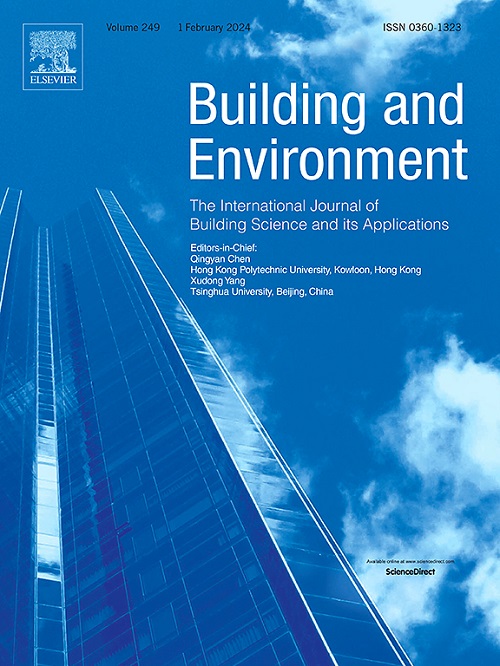Inferring personal daylighting preferences using HDRI and deep learning techniques
IF 7.1
1区 工程技术
Q1 CONSTRUCTION & BUILDING TECHNOLOGY
引用次数: 0
Abstract
This paper presents a new method for classifying daylighting preferences based on deep learning models trained with pixelwise similarity features extracted from pairs of luminance maps. A new composite luminance similarity index is developed, which utilizes the pixelwise information from the entire luminance distribution and considers both the direction and magnitude of relative luminance change, instead of instantaneous metrics used in previous studies. The generated luminance and contrast similarity maps were directly used for training convolutional neural network (CNN) models to classify the occupant's visual preferences. Daylighting preference datasets for 11 individuals, collected in real offices using pairwise HDR images with simultaneous binary preference feedback, were used to evaluate the preference classification performance. The results proved the superiority of the luminance similarity index map as a preference indicator variable. CNN models trained with luminance similarity index maps showed impressive classification accuracy for all tested subjects in the dataset and exhibit more stable training and higher test accuracy compared to models trained with raw luminance maps. Common static lighting parameters cannot estimate daylight preferences even when used in powerful computational models; they neglect visual information located in various parts of the visual scene and cannot consider the change in perceived luminance distribution. Utilizing the full potential of HDRI sensing through detailed luminance mapping and feature extraction is an important step toward human-centered daylighting operation.
利用 HDRI 和深度学习技术推断个人日光偏好
本文介绍了一种基于深度学习模型的日光偏好分类新方法,该模型由从亮度图对中提取的像素相似性特征训练而成。该方法利用了整个亮度分布的像素信息,并考虑了相对亮度变化的方向和幅度,而不是以往研究中使用的瞬时指标。生成的亮度和对比度相似性图直接用于训练卷积神经网络(CNN)模型,以对居住者的视觉偏好进行分类。在实际办公室中收集了 11 个人的日照偏好数据集,使用成对的 HDR 图像和同步的二元偏好反馈来评估偏好分类性能。结果证明了亮度相似性指数图作为偏好指标变量的优越性。与使用原始亮度图训练的模型相比,使用亮度相似性指数图训练的 CNN 模型对数据集中的所有测试对象都表现出了令人印象深刻的分类准确性,并表现出更稳定的训练和更高的测试准确性。即使在强大的计算模型中使用普通的静态照明参数,也无法估计日光偏好;这些参数忽略了视觉场景各部分的视觉信息,也无法考虑感知亮度分布的变化。通过详细的亮度映射和特征提取充分发挥 HDRI 传感的潜力,是实现以人为本的日光照明操作的重要一步。
本文章由计算机程序翻译,如有差异,请以英文原文为准。
求助全文
约1分钟内获得全文
求助全文
来源期刊

Building and Environment
工程技术-工程:环境
CiteScore
12.50
自引率
23.00%
发文量
1130
审稿时长
27 days
期刊介绍:
Building and Environment, an international journal, is dedicated to publishing original research papers, comprehensive review articles, editorials, and short communications in the fields of building science, urban physics, and human interaction with the indoor and outdoor built environment. The journal emphasizes innovative technologies and knowledge verified through measurement and analysis. It covers environmental performance across various spatial scales, from cities and communities to buildings and systems, fostering collaborative, multi-disciplinary research with broader significance.
 求助内容:
求助内容: 应助结果提醒方式:
应助结果提醒方式:


